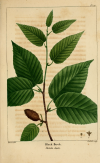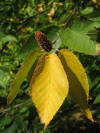WILD
FOODIES' HOME PAGE
PLANT PROFILE LIST
NAME: Sweet Birch
SPECIES / FAMILY: Betula Lenta / Betulaceae
OTHER COMMON NAME(S): Black Birch, Cherry Birch, Yellow
CONDITIONS: sun-partial shade
|
PARTS: |
EDIBLE |
TASTE |
RAW/COOK |
SEASON |
|
All |
|
|
|
|
|
Shoots |
|
|
|
|
|
Leaves |
|
|
COOK |
spring |
|
Stalk/Stem |
|
|
|
|
|
Buds |
||||
|
Flowers |
|
|
|
|
|
Fruits |
|
|
|
|
|
Pods |
|
|||
|
Seeds |
|
|
|
|
|
Nuts |
|
|
|
|
|
Roots |
|
|
|
|
|
Bark |
|
rootbeer |
RAW/DRY/COOK |
all |
|
Sap |
|
sweet |
RAW/COOK |
late winter |
PORTION: small
COMMENT: The Birch Beer (or Root Beer) aroma when you break off the end of a twig is unforgettable! This is definitely an occasion where you use the "scratch and sniff" (the twig) method for identification. // Use the last 12 inches of woody, not green branches. You can drink the sap and make syrup, beer, wine or vinegar out of it, or sugar. You can make a tea from the root bark, leaves or branch tips or eat the tips. Very young leaves can be eaten or used for flavoring.(2) Inner bark - cooked or dried and ground into a powder. Sweet and spicy. The dried inner bark can be used as a thickener in soups etc or can be added to flour when making bread etc.. Sap - raw or cooked. A sweet flavour. It is harvested in early spring, before the leaves unfurl, by tapping the trunk. The flow is best on sunny days following a heavy frost. A delicious drink, it can also be concentrated into a syrup or sugar. The sap can be fermented to make birch beer or vinegar. The dried leaves and bark from the larger roots are a delightful tea substitute. A wholesome, agreeable tea is made from the essential oil contained in the inner bark and twigs. This essential oil is also used as a wintergreen flavouring in foods.(1) See below Birch Beer Recipes (5,6). To avoid the alcohol content, simply add honey or other sugar
RELATED SPECIES: Yellow Birch is less tasty, but can be used in the same manner. https://pfaf.org/user/Plant.aspx?LatinName=Betula+alleghaniensis
CAUTION: The “essential oil” obtained from the bark contains 97 - 99% methyl salicylate. (Editor: It should be noted that many, if not all, essential oils can be toxic if taken orally.) This is very toxic when taken orally, and it can also be absorbed through the skin, resulting in human fatalities. 4,700 mg can be fatal in children. The aromatic and aliphatic hydrocarbons in birch tar are irritating to the skin. Do not use in patients with oedema or with poor kidney or heart functions.(1)
NUTRITION/MEDICINAL: Analgesic; Anthelmintic; Antiinflammatory; Antiseborrheic; Astringent; Diaphoretic; Diuretic; Rubefacient;
Stimulant.(1) Also: https://www.webmd.com/vitamins/ai/ingredientmono-352/birch - The leaves of the tree, which contain lots of vitamin C, are used to make medicine.
LOOK-A-LIKES:
POISONOUS LOOK-A-LIKES:
OTHER USES: You can make cups to baskets to canoes out of the bark. Birch resin, or tar, was the first super glue. Archaeological research shows it has been used for at least 80,000 years: A spear point is extant with a Neanderthal thumb print in the tar. There also exists 11,000 year old bits of Birch tar with human teeth marks… crude chewing gum. Ancient Greeks used the tar to mend broken pottery. Birch tar is solid at 65°F, moldable at 85°F, a stiff putty at 105°F, a soft sticky putty at 135°F and boils at 352°F. Birch tar is not made from the sap but rather the bark itself, heated in an oven with little air (similar to making charcoal.) The bark expresses an oil that runs out a small hole in the bottom of the oven. When it cools it’s waterproof and not brittle. Among the tar’s many uses was to glue arrowheads to shafts.(2) Essential; Fuel; Tannin; Wood. An essential oil is obtained from the bark and twigs, it is distilled in quantity and is an item of commerce. It can be used medicinally, as a food flavouring, as an ingredient in cosmetic shampoos and also to make a wholesome tea. The oil, when decolourized, is similar to 'Oil of Wintergreen' (obtained from Gaultheria procumbens) and is considered to be of superior quality. The oil distilled from the wood is insect repellent. The bark contains up to 16% tannin. The thin outer bark is waterproof and has been used as the outer cladding on dwellings, canoes etc. It has also been used to make baskets, dishes, buckets etc. Wood - very strong, close grained, hard, heavy. The wood is richly marked, used for making floors, furniture, tools etc.(1)
SOURCE LINKS (may include nutritional and medicinal info, plus other uses):
-
https://pfaf.org/USER/Plant.aspx?LatinName=Betula+lenta
https://pfaf.org/user/Plant.aspx?LatinName=Betula+alleghaniensis (Yellow Birch) - http://www.eattheweeds.com/birches
- https://en.wikipedia.org/wiki/Betula_lenta / https://commons.wikimedia.org/wiki/Betula_lenta
- https://ouroneacrefarm.com/wintergreen-extract-birch (also Yellow Birch, good photos)
- https://defeatingpain.wordpress.com/tag/birch-bark-tincture (lots of interesting info on food and medicine)
- https://notastelikehome.org/2018/02/05/birch (recipe)
- https://www.justapinch.com/recipes/non-editible/other-non-edible/uses-for-sweet-birch.html (photo is of white birches, but recipe is good)
- https://www.cooks.com/recipe/vg8zw72m/birch-beer.html (recipe)
- https://www.leaf.tv/articles/how-to-make-homemade-birch-beer
- https://davebakes.com/2015/03/29/brown-butter-birch-cupcakes-for-my-birthday
- https://waldenlabs.com/uses-for-birch-sap/ "During the last real famine in Sweden, in 1867, tree-sap was widely used in the southernmost part of Sweden, for bread, gruel and as a mealtime drink. Birch was therefore referred to as the “poor-man's cow”, according to one record from southern Sweden.”




